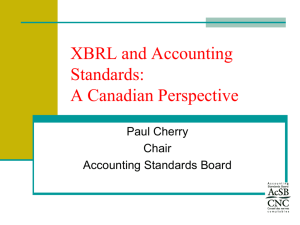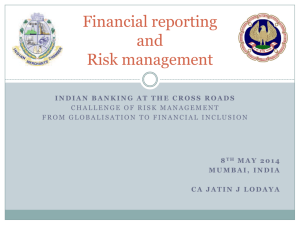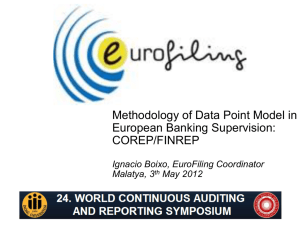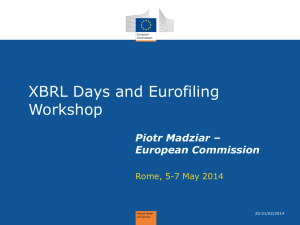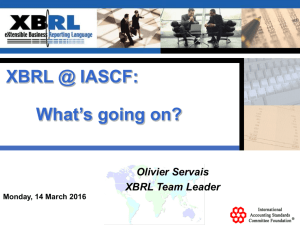Practical Implementation of FINREP and COREP Taxonomies
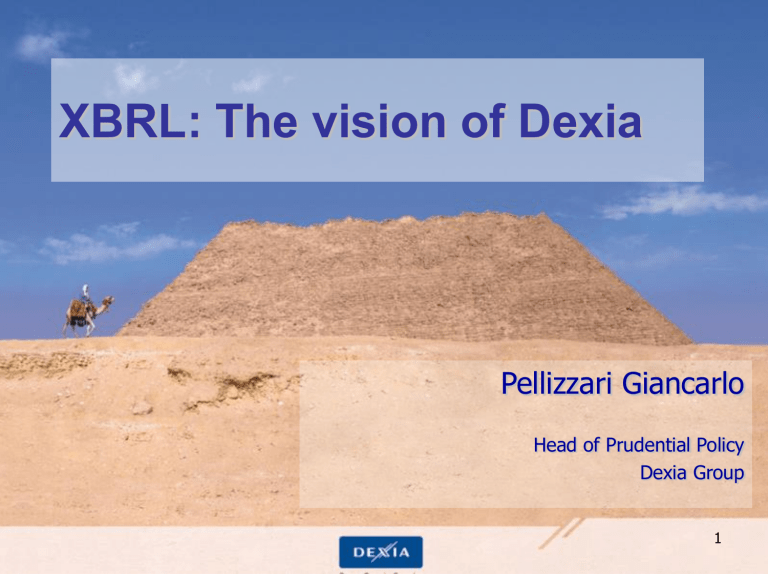
XBRL: The vision of Dexia
Pellizzari Giancarlo
Head of Prudential Policy
Dexia Group
1
Agenda
Dexia: an European group
The regulatory environment
Main challenges
Complexity ?
XBRL
Where are we ?
Where do we go ?
How to do it ?
EU-US convergence
Conclusions
2
Dexia: an European group
Dexia Holding:
27,5 EURBn Capitalization, world leader in public financing
Dexia Bank Belgique
Dexia Crédit Local (France)
Dexia BIL (Luxembourg)
FSA (Financial Security Assurance) – USA – Credit enhancement
Dexia Insurance Belgium
Deniz Bank (6th largest private bank in Turkey)
Factoring, leasing, real estate, IT, etc.
A group of 241 entities, 33.321 staff members and present in 33 countries
3
Dexia: an European group
Business portfolio : Segment contribution to net income - Group share (1)
(1) Excluding non-operating items and central assets Treasury and Financial
Markets
Asset
Management 14%
Investor Services
Insurance
5%
4%
4%
51%
22%
Personal Financial
Services
Net income – Group share
Public/Project Finance and Credit enhancement
FY 2005: EUR 2,038 M
FY 2006: EUR 2,750 M
4
The regulatory environment
Home – host supervisors:
Home supervisors (working in a college)
CBFA – Belgian Banking, Finance and Insurance Commission (as lead supervisor)
The French Commission Bancaire
Commission de Surveillance du Secteur Financier (Luxembourg)
Host supervisors
EU supervisors
Bundesbank – Bafin (Germany)
Banca d’Italia (Italy)
Banco d’Espana (Spain)
Etc.
Other countries
BRSA (Turkey)
SEC (USA)
OFSI (Canada)
Japan FSA
Singapore
Etc.
5
The regulatory environment
The reporting
COREP
Group level : Belgium
Entity level : Belgium, France, Luxembourg
Subsidiary level : Italy, Austria, Germany, etc.
FINREP
Group level : no reporting required
Entity level : Belgium, France, Luxembourg
Subsidiary level : Italy, Austria, etc.
Others:
USA requirements, Solvency ratio, local requirements
6
Main challenges
Cross regime requirements (IFRS, Basel II, Solvency II)
Cross country interpretation (within one single regime)
Cross business needs (Risk, Accounting, Business control, others ?)
Timeline for implementing CEBS update in the IT systems of the bank:
CEBS release March 200x
End of consultation June 200x
Application for March 200x+1
Without taking into account the national extensions…
All these should be integrated in
One IT system
One platform
One database 7
Complexity ?
Basel II IFRS Solvency II
Pillar I Pillar III IFRS 7 F/S Pillar III Pillar I
+ notes
Group Group Group Group
BE FR LU BE FR LU BE FR LU BE FR LU
BE (+group) BE
8
XBRL: the current situation
Entité de booking X
Systèmes comptables
Systèmes de gestion
Risque de marché
FERMAT
Risque opérationnel
J-Port
MAGNITUDE Fichiers DMV3
FERMAT
Table données INPUT
Moteur de calcul RWA
Résultats détaillés
Résultats agrégés
Risque
Crédit
Reporting réglementaire
Résultats agrégés
Risque
Marché
Résultats agrégés
Risque
Opérationnel
Données
Fonds
Propres
Résultats agrégés
Comptables
Etats
COREP
Etats
FINREP
9
XBRL: the current situation
(the accounting environment)
Dexia group
IFRS
BIL group
IFRS
Dexia Bank group
IFRS
Deniz Bank Group
IFRS
Dexia Crédit Local group
IFRS
RBC - DFS
IFRS
Dexia Asset
Management group
Lux
GAAP
Dexia Insurance group
IFRS
Banking institutions
Insurance companies
Other
Adinfo group
No Conso
(BE
GAAP)
Crediop
IFRS
FSA
US
GAAP
10
XBRL: the current situation
(the accounting environment)
STATUTORY CONSOLIDATED
SAP
Holding
CONSO
DHLD
BE
CONSO
DBB
INTERNAL
REPORTING
FR
LU
DBB
DCL
MAGNITUDE
COMMON PARAM
CONSO
DCL EXTERNAL
REPORTING
SPEC. LOCAL PARAM
CONSO
DBL
CHECK CHECK
FINREP
XBRL
COREP
XBRL
DBL VISUAL
SCOPE
MIS CONSO
ESSBASE
11
XBRL: the current situation
Many EU countries where Dexia is active are using XBRL as reporting language but
Not in all countries
Mostly presented and implemented as an additional burden
In Belgium an additional XBRL reporting is required for the Balance Sheet Office reporting
(statutory accounts of approx 270.000 companies), National Bank of Belgium.
12
XBRL: Advantages
Use XBRL as a tool for more harmonization, flexibility and gain of time both vertically and horizontally
We thus need:
XBRL at the beginning of the reporting processes (public, COREP,
FINREP and internal)
Softwares that read XBRL
One integrated database (kind of Group taxonomy)
« One fits all »
13
XBRL: Advantages
Used by credit departments
Used instead of xls on websites (like Microsoft, Monte dei Paschi di Siena, etc.)
Other regulatory reporting (like VAT and tax in NL, AML in Spain, etc.)
Internal reporting (reconciliation Consolidation and Risk databases)
Mapping with new regulatory requirements
Necessity to create a working group within the group with technical specialists and business specialists
Better coordination
Decrease of cost
14
XBRL: Advantages
A potential integration tool for the group reporting
External :
Known and understood by all
May be the base of a worldwide reporting
May avoid repetitive reporting in different presentations, but with the same content to regulators and local authorities
Internal :
May be the base for internal reporting (consolidation)
May allow “drill-down” analysis with a good organisation of taxonomy
Will make the life easier for Financial Communication and members of the
Boards when they compare the contribution of one company in the consolidated accounts with the financial statements published by a subsidiary in its country
15
XBRL: Advantages
A potential integration tool for groups
Only one reporting, for internal and external reporting
Possibilities for people to move from one company to another
Advantage for managers to understand how transactions are recorded and the impact on the financial statements
Powerful tool for the controller and people from investor relations to analyse the contents of the financial statements, both in the group and sub – groups, including the local regulatory reporting
Use of IFRS and worldwide taxonomy may help groups to more easily integrate newly acquired subsidiaries
16
XBRL: the issues
Regulatory interpretations
Example
Collateral definition
Equity split
Counterparties
Calculations
Etc.
Software offer
COREP + FINREP
IFRS
Internal
Motivation of people (difficulty to see the benefits)
17
How to solve it ?
Stronger CEBS policy, but also more communication to banks with regards to the
XBRL benefits (XBRL should not be a cost and administrative burden)
Stronger banking industry involvement
Software providers needs to understand the banks’ real needs
One single definition of taxonomy
18
EU – US convergence
Press release of April 2007: cooperation between US and EU, including regulatory matters
BUT:
This way ?
FSA
Bundes bank
SGCB BdI CBFA etc.
SEC-FDIC
EU CEBS
Or this way ?
19
Conclusion
Within ONE group
ONE tag
ONE definition
ONE validation/business rule
ONE taxonomy
ONE country
ONE EU reporting
ONE CEBS (FINREP-COREP) EU base reporting completed by additional country requirements
=> Need to follow the XBRL principles
20


